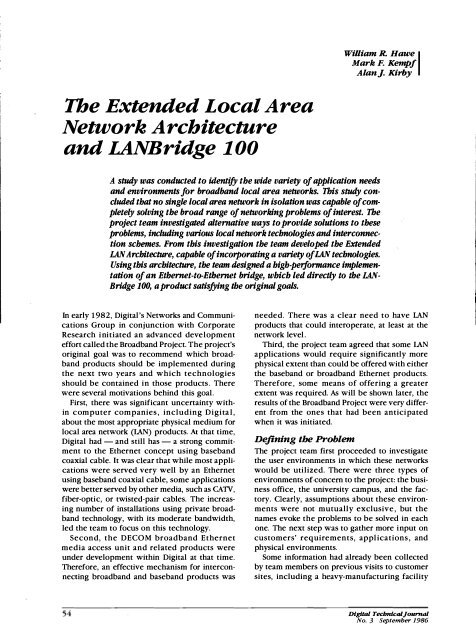DTJ Number 3 September 1987 - Digital Technical Journals
DTJ Number 3 September 1987 - Digital Technical Journals
DTJ Number 3 September 1987 - Digital Technical Journals
You also want an ePaper? Increase the reach of your titles
YUMPU automatically turns print PDFs into web optimized ePapers that Google loves.
WiUiam R. HaweMark F. KempfAlanJ. Kirby IThe Extended Local AreaNetwork Architectureand LANBridge 100A study was conducted to identify the wide variety of application needsand environments fo r broadband local area networks. This study concludedthat no single local area network in isolation was capable of completelysolving the broad range of networking problems of interest. Theproject team investigated alternative ways to provide solutions to theseproblems, including various local network technologies and interconnectionschemes. From this investigation the team developed the ExtendedLAN Architecture, capable of incorporating a variety of LAN technologies.Using this architecture, the team designed a high-performance implementationof an Ethernet-to-Ethernet bridge, which led directly to the !ANBridge 100, a product satisfying the original goals.In early 1982, <strong>Digital</strong>'s Networks and Communi·cations Group in conjunction with CorporateResearch initiated an advanced developmenteffort called the Broadband Project. The project'soriginal goal was to recommend which broadbandproducts should be implemented duringthe next two years and which technologiesshould be contained in those products. Therewere several motivations behind this goal.First, there was significant uncertainty withincomputer companies, including <strong>Digital</strong>,about the most appropriate physical medium forlocal area network (IAN) products. At that time,<strong>Digital</strong> had - and still has - a strong commitmentto the Ethernet concept using basebandcoaxial cable. It was clear that while most applicationswere served very well by an Ethernetusing baseband coaxial cable, some applicationswere better served by other media, such as CATV,fiber-optic, or twisted-pair cables. The increasingnumber of installations using private broadbandtechnology, with its moderate bandwidth,led the team to focus on this technology.Second, the DECOM broadband Ethernetmedia access unit and related products wereunder development within <strong>Digital</strong> at that time.Therefore, an effective mechanism for interconnectingbroadband and baseband products wasneeded. There was a clear need to have LANproducts that could intemperate, at least at thenetwork level .Third, the project team agreed that some IANapplications would require significantly morephysical extent than could be offered with eitherthe baseband or broadband Ethernet products.Therefore, some means of offering a greaterextent was required. As will be shown later, theresults of the Broadband Project were very differentfrom the ones that had been anticipatedwhen it was initiated.Defining the ProblemThe project team first proceeded to investigatethe user environments in which these networkswould be utilized. There were three types ofenvironments ofconcern to the project: the businessoffice, the university campus, and the factory.Clearly, assumptions about these environmentswere not mutually exclusive, but thenames evoke the problems to be solved in eachone. The next step was to gather more input oncustomers' requirements, applications, andphysical environments.Some information had already been collectedby team members on previous visits to customersites, including a heavy-manufacturing facility54<strong>Digital</strong> Tecbnk4ljournalNo. 3 <strong>September</strong> 1986









